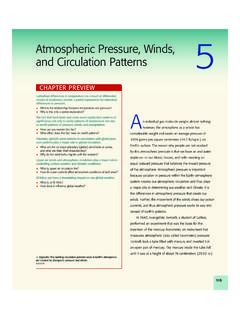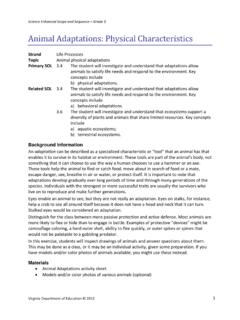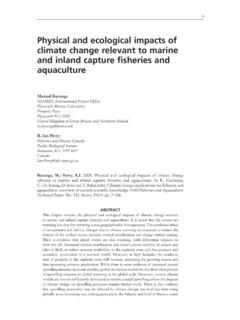Transcription of Physical Geography: Earth Environments and …
1 1 Physical geography : Earth Environments and SystemsPhysical geography investigates and seeks to explain the spatial aspects, functions, and characteristics of Earth s Physical is geography often called the spatial science?Why are the topics of spatial interaction and change important in Physical geography ?Although it is closely related to many other sciences, Physical geography has its own unique focus and perspectives for study-ing are the three major perspectives of Physical geography ?Why is a holistic approach important to understanding Physical geography ?
2 The use of models and the analysis of various Earth systems are important research and educational techniques used by kinds of models may be used to portray Earth , its features, and its Physical processes?In what ways can systems analysis lead to an understanding of complex Environments ?Unlike some other Physical sciences, Physical geography places a special emphasis on human environment is geography so important in the study of the environmental sciences today?Why do ecosystems provide such excellent opportunities for Physical geographers to study the interactions between humans and the natural environment?
3 Every Physical environment offers an array of advantages as well as challenges or hazards to the human residents of that environmental adaptations are necessary for humans to live in your area?What impacts do humans have on the environment where you live? CHAPTER PREVIEW Earth s incredible environmental diversity: An oasis of life in the vastness of provided by GeoEye and NASA SeaWiFs Project V iewed from far enough away to see an entire hemisphere, Earth is both beautiful and intriguing a life-giving planetary oasis. From this perspective we can begin to appreciate the big picture, a global view of our planet s Physical geography through its display of environmental diversity.
4 Characteristics of the oceans, the atmosphere, the landmasses, and evidence of life as revealed by vegetated regions, are apparent. Looking carefully, we can recognize geographic patterns, shaped by the processes that make our world dynamic and ever-changing. Except for the external addition of energy from the sun, our planet is a self-contained system that has all the requirements to sustain may seem immense and almost limitless from the perspective of humans living on its surface. In contrast, viewing the big picture reveals its conspicuous limits and fragility a spherical island of life surrounded by the vast, dark emptiness of space.
5 However, from our vantage point in space, we cannot comprehend the details of how processes involving air, water, land, and living things interact to create a diverse array of landscapes and environmental conditions on Earth . These distant images display the basic aspects of Earth that make our existence possible, but they only hint at the complexity of our planet. Being aware of the big picture is important, but this knowledge should be bolstered by a detailed understanding of how Earth s features and processes interact to develop the extraordinary 3 55061_01_Ch01_p002_027 355061_01_Ch01_p002_027 36/10/08 11:20:33 AM6/10/08 11:20:33 AMCHAPTER 1 Physical geography : Earth Environments AND SYSTEMS4environmental diversity that exists on our planet.
6 Developing this understanding is the goal of a course in Physical geography . The Study of GeographyGeography is a word that comes from two Greek roots. Geo- refers to Earth , and -graphy means picture or writing. The primary objective of geography is the examination, description, and explanation of Earth its variability from place to place, how places and features change over time, and the processes responsi-ble for these variations and changes. geography is often called the spatial science because it includes recognizing, analyzing, and explaining the variations, similarities, or differences in phenomena located (or distributed) on Earth s surface.
7 The major geographic organizations in the United States have provided us with a good description of is something located? Why is it there? How did it get there? How does it interact with other things? geography is not a collection of arcane information. Rather it is the study of spatial aspects of human everywhere need to know about the nature of their world and their place in it. geography has much more to do with asking questions and solving problems than it does with rote memorization of what exactly is geography ? It is an integrative discipline that brings together the Physical and human dimensions of the world in the study of people, places, and Environments .
8 Its sub-ject matter is the Earth s surface and the processes that shape it, the relationships between people and Environments , and the connections between people and Education Standards Project, 1994 geography for LifeGeography is distinctive among the sciences by virtue of its definition and central purpose. Unlike most scientists in related disciplines (for example, biologists, geologists, chemists, economists), who are bound by the phenomena they study, geographers may focus their research on nearly any topic related to the scientific analysis of human or nat-ural processes on Earth ( Fig.)
9 Geographers generally consider all of the human and natural phenomena that are relevant to a given problem or issue; in other words, they often take a holistic approach to understanding aspects of our study the Physical and/or human charac-teristics of places, seeking to identify and explain characteris-tics that two or more locations may have in common as well as why places vary in their geographic attributes. Geogra-phers gather, organize, and analyze many kinds of geographic data and information, yet a unifying factor among them is a focus on explaining spatial locations, distributions, and rela-tionships.
10 They apply a variety of skills, techniques, and tools to the task of answering geographic questions. Geographers also study processes that influenced Earth s landscapes in the past, how they continue to affect them today, how a landscape may change in the future, and the significance or impact of these geography embraces the study of virtually any global phenomena, it is not surprising that the subject has many sub-divisions and it is common for geographers to specialize in one or more subfields of the discipline. geography is also subdivided along academic lines; some geographers are social scientists and some are natural scientists, but most are involved in studying hu-man or natural processes and how they affect our planet, as well as the interactions among these processes.
















